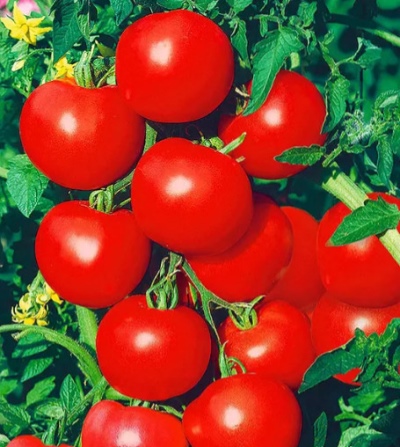
- Authors: Guseva L.I., Nikulaesh M.D., Myazina L.A., Dvornikov V.P., Pivovarov V.F., Mamedov M.I.O., Zhavoronkov V.A. (Transnistrian Research Institute of Agriculture, Moldova)
- Year of approval: 1997
- Name synonyms: Snegopad
- Category: hybrid
- Growth type: indeterminate
- Appointment: fresh consumption
- Ripening period: late ripening
- Ripening time, days: 121-129
- Growing conditions: for open ground
- Bush size: tall
Tomato Snowfall is relatively unpretentious when grown. And tomatoes do not undergo cracking, they are well stored for a long time. But the main values of the crop are high yields and strong immunity.
Breeding history
Tomato Snowfall belongs to the 1st generation hybrids, it was bred in the late 90s of the twentieth century on the basis of the Transnistrian Research Institute of Agriculture in Moldova. A whole group of breeders worked on the creation of a hybrid variety, among them were such specialists as L. I. Guseva, L. A. Myazina, M. D. Nikulaesh, V. F. Pivovarov, M. I. O. Mamedov, V. Dvornikov P., Zhavoronkov V.A.A synonym for culture - Snegopad. In 1997, Snowfall was entered in the state register and received permission for use.
Description of the variety
The plant has an indeterminate type of growth, it is a non-standard variety. The height of the bush can be up to 200 centimeters. Plants branch quite strongly, they are medium-leafy. The foliage is ordinary, large, colored in a shade of dark green. Strong corrugation is observed on the leaves, there are stipules. The first of the simple loose inflorescences is located above the 8-9 leaves, then they come after every third leaf. On the bush, you can see 7-8 brushes, on each bunch there can be 8-10 fruits ripening at the same time. The stem of the bush is green, rather thick, with subtle edges. The variety has a high tying rate.
The main qualities of the fruit
Snowfall tomatoes have a beautiful rounded shape, they are all smooth and shiny. The unripe fruit is colored green; the stalk has a dark spot. Ripe berries have a bright red color; after ripening, the spot disappears. Tomatoes are medium-sized, weighing on average 58-72 g, but they can grow up to 130 grams. Inside there are two to three seed chambers. A slight ribbing can be seen at the peduncle.
Storage of ripe tomatoes is possible for about 2 months, while the temperature can even be room temperature.
Taste characteristics
The fleshy pulp of the Snowfall fruit is dense, juicy, very pleasant to the taste. Tasters assess the taste as rich, sweetish, with a delicate aroma.
Tomatoes are eaten fresh and processed. Suitable for making salads, sauces, they are also added to various dishes. Tomatoes behave great when freezing and canning. The product contains a large amount of sugar, which is why it is often used in the diet of children.
Composition per 100 grams of wet matter:
- dry matter - 5.4-6.0%;
- total sugar - 2.0-2.5%;
- ascorbic acid - 11.9-13.1 mg.
Ripening and fruiting
Late-ripening tomato Snowfall has a long fruiting period. The crop ripens, as a rule, 121-129 days after the first shoots. The beginning of fruit picking falls on July-August, lasts until cold snaps.
Yield
Typically, 3.7-4.3 kg are harvested from each plant.
The timing of planting seedlings and planting in the ground
Snowfall seeds are sown for seedlings in March. The grown seedlings are transferred to open ground in May.

Growing tomato seedlings is an extremely important process, because it largely depends on whether the gardener will be able to harvest at all. All aspects must be taken into account, from seedbed preparation to planting in the ground.
Landing scheme
When planting, a distance of 35 cm is maintained between the bushes, and 60 cm between adjacent rows. This is the optimal scheme.

Growing and care
Tomato bush Snowfall looks like a tall and spreading plant, so it is necessary to carry out both shaping and pinching. And also the trunks must be tied to a trellis or any solid support. Further care does not differ from activities for the cultivation of other tomatoes.
So, the culture should be watered regularly, 2 to 3 times a week. Further, during the growing season, it is necessary to make a number of nutritional supplements. The first feeding is done 7 days after the seedlings are placed in the ground - these are mineral fertilizers, which contain nitrogen (urea, ammonium nitrate). The next feeding will be carried out in a month and include potassium-phosphorus supplements. It is possible to repeat the last procedure after another month.




A plant needs different micronutrients at each stage of growth. All fertilizers can be divided into two groups: mineral and organic. Folk remedies are often used: iodine, yeast, bird droppings, eggshells.
It is important to observe the rate and period of feeding. This also applies to folk remedies and organic fertilizers.
Disease and pest resistance
Hybrids, as a rule, have a fairly high immunity. So, the culture under consideration has resistance to the main ailments of nightshades: to almost all fungal diseases and TMV (tobacco mosaic virus). True, in rare cases, the tomato is affected by anthracnose, as well as alternaria.



























































































